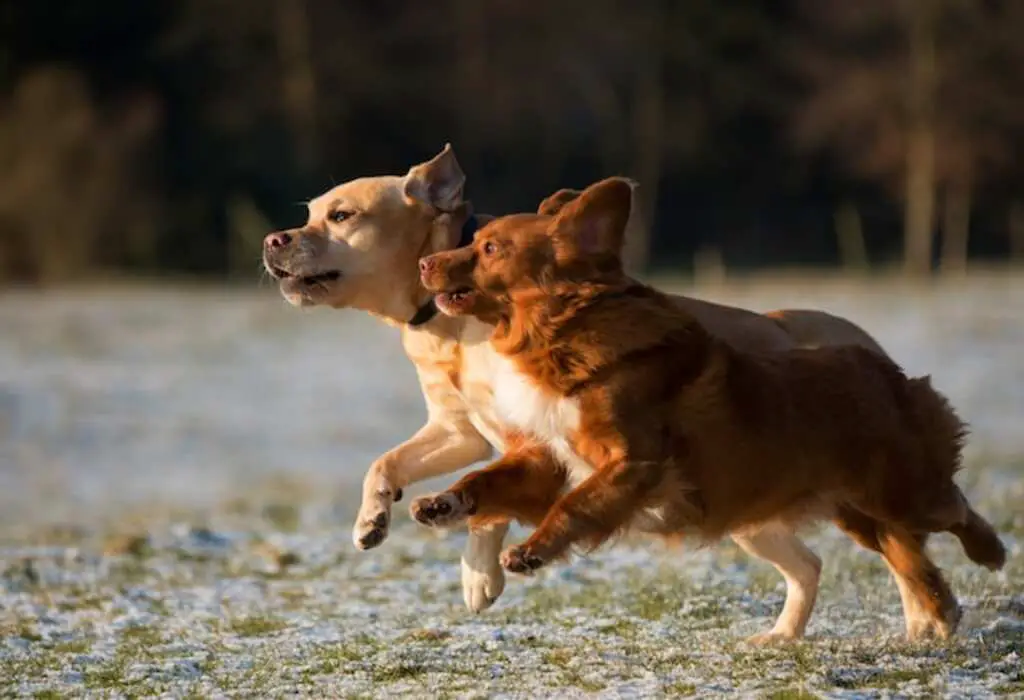Are you wondering when do dogs mature and calm down? While every dog is different, most dogs will reach this stage around the age of 2–3 years old. However, it’s important to keep in mind that this timeline can vary depending on the breed and individual dog. Some breeds may remain energetic even into their senior years.
Proper training, exercise, and socialization can help manage a dog’s energy levels and promote calm behavior. Additionally, neutering or spaying can also have a positive impact on a dog’s behavior.
In this blog, we’ll explore the factors that contribute to a dog’s maturity and calmness, as well as tips for promoting good behavior in your furry friend. Whether you’re a new dog owner or a seasoned pro, this blog is for you!
Key Takeaways
- Dogs typically mature and calm down between 12 to 24 months of age, depending on the breed.
- Smaller breeds tend to mature faster than larger breeds.
- Factors such as exercise, training, and socialization can also affect a dog’s behavior and temperament.
- Some dog breeds may remain high-energy and playful throughout their lives.

When Do Dogs Mature and Calm Down?
Dogs typically mature and calm down between 12 and 24 months of age, depending on the breed. Smaller breeds tend to mature faster than larger breeds. Factors such as exercise, training, and socialization can also affect a dog’s behavior and temperament.
Some dog breeds may remain high-energy and playful throughout their lives. It’s important to provide dogs with proper care and attention to help them develop good behavior and temperament.
If you have concerns about your dog’s behavior, it’s always best to consult with a veterinarian or professional dog trainer.
Age and Maturity in Dogs
As with humans, dogs go through different stages of development as they age, and each stage brings changes in behavior. Understanding these stages can help pet owners to better understand their dogs and address any behavior issues that may arise.
The first stage of development is the puppy stage, which lasts until the dog is about 1 year old. During this stage, puppies are very active and playful, exploring their world and learning social skills from their littermates and mother. As they approach adulthood, around 6 months old, puppies may start to exhibit behavior such as marking territory or showing aggression towards other dogs.
The second stage of development is adolescence, which lasts from about 1 year old to 2 years old. During this stage, dogs may become more independent and start to test boundaries. They may also become more aggressive towards other dogs or people, and may exhibit destructive behavior such as chewing or digging. It is important for pet owners to establish themselves as the pack leader during this stage and work to reinforce positive behavior.
- Tips: To help dogs develop good behavior habits as they mature, it is important to socialize them early on and provide plenty of positive reinforcement for desirable behavior. Consistency in training is also key, as dogs respond well to routine and structure.
- Tips: Providing plenty of exercise and mental stimulation can also help to redirect a dog’s energy in a positive way and prevent destructive behavior.
Breed and Temperament
Another important factor in determining when dogs mature and calm down is breed and temperament. Different breeds have different energy levels and tendencies, which can affect how quickly they reach maturity.
For example, breeds that were originally bred for hunting or herding, such as terriers or border collies, tend to be more energetic and high-strung, and may take longer to calm down. On the other hand, breeds that were bred for companionship or relaxation, such as bulldogs or shih tzus, may mature and calm down earlier.
It’s also important to consider a dog’s individual temperament. Some dogs are naturally more anxious or excitable than others, and may take longer to reach a state of calmness and maturity. Understanding your dog’s temperament and adjusting your training and behavior accordingly can help them develop good behavior habits and become calmer and more well-behaved.
Settling Down: When do Puppies Mature?
Puppies are known for their boundless energy and mischievous behavior. However, as they grow and mature, their behavior will inevitably change. Understanding the stages of puppy development can help you anticipate these changes and adjust your training techniques accordingly.
| Age | Behavior |
|---|---|
| 0-7 weeks | Puppies are completely dependent on their mother and littermates. They are learning important socialization skills, and their primary focus is on eating, sleeping, and staying warm. |
| 8-12 weeks | Puppies are becoming more aware of their surroundings and are starting to explore the world around them. They are also beginning to develop their own personalities and preferences. |
| 3-6 months | Puppies are going through a critical period of development. They may become more independent and stubborn as they begin to test boundaries. This is an important time to establish rules and boundaries through consistent training. |
| 6-12 months | Puppies are entering adolescence and may exhibit increased energy levels and selective hearing. They may also experience some fear and anxiety as they encounter new situations. Consistent training and socialization can help them navigate these challenges. |
It’s important to remember that every puppy is different and may not follow this exact timeline. However, by understanding the stages of puppy development, you can better anticipate and address changes in behavior as your puppy matures.

Hyperactive Dogs: When Do They Calm Down?
Hyperactivity is a common concern among dog owners, particularly those with young puppies. So when can you expect your furry friend to finally settle down? The answer varies depending on breed and individual temperament, but there are some general guidelines.
Most dogs begin to mature around the age of two, when their energy levels start to decrease and their personalities begin to solidify. However, some breeds may take longer to reach this stage, while others may mature more quickly. For example, a high-energy breed like a Border Collie may take longer to calm down than a laid-back breed like a Basset Hound.
While genetics play a major role in determining a dog’s temperament, training and socialization can also have a huge impact. Dogs that are exposed to a variety of people, animals, and environments from a young age are more likely to be well-adjusted and calm as adults. Additionally, consistent training that focuses on positive reinforcement can help dogs learn to control their impulses and behave appropriately.
If you’re struggling with a hyperactive dog, here are some tips to help you both stay calm:
- Provide plenty of exercise and mental stimulation to help burn off excess energy.
- Create a consistent daily routine that includes designated meal times, play times, and rest times.
- Use positive reinforcement training techniques to encourage good behavior and discourage bad habits.
- Avoid punishment-based training methods that can cause anxiety and aggression.
- Consider incorporating calming products like pheromone sprays or calming supplements into your dog’s routine.
Remember, every dog is unique and may take a different amount of time to reach maturity. If you’re concerned about your dog’s hyperactivity levels or behavior, don’t hesitate to reach out to a professional dog trainer or behaviorist for guidance.
“Most dogs begin to mature around the age of two, when their energy levels start to decrease and their personalities begin to solidify.”
Signs of Maturity in Dogs
Recognizing when your dog has reached maturity is an important part of being a responsible dog owner. While the age at which a dog reaches maturity can vary depending on breed and individual factors, there are some common signs to look out for:
- Decreased energy levels: Mature dogs are often less energetic than younger dogs, preferring to relax and rest more often. If your dog is no longer bouncing off the walls or demanding constant playtime, they may have reached maturity.
- Emotional stability: Mature dogs tend to be more emotionally stable, exhibiting less anxiety, fear, and hyperactivity than younger dogs. If your dog is calmer and more relaxed in stressful situations, they may have reached maturity.
- Consistent behavior: Mature dogs are more predictable in their behavior than younger dogs, and are less likely to exhibit sudden changes in mood or personality. If your dog is displaying consistent behavior and responding well to training, they may have reached maturity.
It’s important to keep in mind that the signs of maturity can vary depending on the individual dog and their breed. Some dogs may take longer to mature than others, while certain breeds may exhibit hyperactivity or high energy levels well into adulthood.
Additionally, it’s important to adjust your behavior and training techniques as your dog reaches maturity. While a young and energetic dog may have required lots of exercise and playtime to stay stimulated, a mature dog may benefit more from calmer activities like walks and stretching exercises to keep them healthy and happy.
Training for Calm Behavior
Dogs, like people, need guidance and structure to learn good behavior habits. Training your dog to be calm and well-behaved requires consistency, patience, and positive reinforcement. Here are some tips and strategies to help you train your dog to exhibit calm behavior:
- Start with basic obedience training: Teach your dog basic commands such as “sit,” “stay,” and “come” using positive reinforcement techniques like treats and praise. This will help establish a foundation of good behavior habits.
- Use positive reinforcement: Reward your dog for exhibiting calm behavior with treats, praise, and playtime. Avoid punishment or negative reinforcement, as it can lead to anxiety and fear in your dog.
- Schedule regular exercise: Dogs need regular exercise to burn off excess energy and maintain good physical health. Schedule regular walks or playtime sessions to help your dog stay calm and relaxed.
- Establish a consistent routine: Dogs thrive on routine and predictability. Establish a consistent daily routine for feeding, exercise, and rest to help your dog feel calm and secure.
- Teach relaxation techniques: Teach your dog relaxation techniques such as “down” or “stay” to help them learn how to settle down and relax when needed.
- Consider calming supplements: Some dogs may benefit from natural calming supplements such as CBD oil or chamomile. Always consult with your veterinarian before giving your dog any new supplements.
- Be patient: Changing a dog’s behavior takes time and patience. Avoid getting frustrated or giving up, and keep working with your dog consistently and positively.
By following these tips and techniques, you can help your dog learn to exhibit calm behavior and become a well-behaved member of your family.

Breed-Specific Maturity and Calmness
Not all dog breeds mature and calm down at the same rate. Some breeds tend to be more energetic and high-strung, while others are naturally calmer and more mellow. Understanding how breed factors into a dog’s maturity and temperament can help you better address their behavior needs.
| Breed | Approximate Age of Maturity | Calmness Level |
|---|---|---|
| Golden Retriever | 2-3 years | High |
| Chihuahua | 1-2 years | Low |
| Greyhound | 2 years | High |
| Bulldog | 3 years | Low |
These are just a few examples and each individual dog may mature differently depending on various factors. However, it is generally agreed upon that smaller breeds tend to mature faster than larger breeds. Additionally, breeds that were originally bred for working or sporting purposes may take longer to mature and require more physical activity to remain calm.
It’s important to remember that breed is just one factor that contributes to a dog’s maturity and temperament. Each dog is an individual with their own unique personality and behavior needs.
Tips to Help Dogs Calm Down
If you’re struggling with a hyperactive or overly energetic dog, there are several steps you can take to help them calm down and exhibit better behavior. Here are some tips:
1. Regular Exercise
One of the best things you can do to help your dog calm down is to make sure they are getting enough exercise. Regular walks, runs, and playtime can help burn off excess energy and keep them more relaxed throughout the day.
2. Consistent Routine
Dogs thrive on routine, so try to maintain a consistent schedule throughout the day. This can include regular feeding times, exercise times, and bedtime routines. Consistency can help your dog feel more secure and less anxious.
3. Positive Reinforcement Training
Training your dog using positive reinforcement techniques can help them learn to exhibit calmer behavior. Reward good behavior with treats, praise, and playtime, and avoid scolding or punishing them for bad behavior.
4. Calming Products
There are several products on the market designed to help calm anxious or hyperactive dogs. These can include calming supplements, pheromone diffusers, and therapeutic toys. Talk to your veterinarian about which products may be suitable for your dog.
5. Avoid Overstimulation
Avoid overstimulating your dog with too much noise, activity, or attention. This can cause them to become overly excited and make it more difficult for them to calm down. Instead, provide a calm and quiet environment for them to relax in.
6. Consider Professional Help
If your dog’s hyperactivity or anxiety is causing significant problems, consider seeking professional help from a dog trainer or behaviorist. They can help diagnose and address underlying issues that may be contributing to the problem.
Conclusion
In conclusion, dogs generally mature and calm down between 12 and 24 months of age, although this can vary depending on the breed. It’s important to provide dogs with proper exercise, training, and socialization to help them develop good behavior and temperament.
However, it’s also important to remember that some dog breeds may remain high-energy and playful throughout their lives. If you have concerns about your dog’s behavior, it’s always best to consult with a veterinarian or professional dog trainer.

FAQ: Common Questions About Dog Maturity and Calmness
As a dog owner, you may have many questions about when your furry friend will mature and calm down. Here are some common questions and answers to help guide you:
How do I know if my dog is mature?
There are several signs that indicate a dog has reached maturity. These include a more even temperament, decreased energy levels, and less interest in playful behavior. If your dog is exhibiting these behaviors, they may have reached maturity.
When do puppies settle down?
Puppies typically go through several stages of development before they settle down. This can vary depending on the breed, but in general, puppies start to settle down around 6-12 months of age. However, it’s important to note that some breeds may take longer to mature than others.
How can I help my hyperactive dog calm down?
There are several things you can do to help a hyperactive dog calm down. First, make sure they are getting enough exercise and mental stimulation. A tired dog is typically a calmer dog. Additionally, consider training techniques such as positive reinforcement and consistency, as well as incorporating calming supplements or toys into their routine.
What should I do if my dog is exhibiting concerning behavior?
If your dog is exhibiting concerning behavior, such as aggression or destructive behavior, it’s important to seek professional help. Talk to your vet or a certified dog trainer to get a better understanding of what may be causing the behavior and how to address it.
How long does it take for a dog to mature?
The time it takes for a dog to mature can vary depending on the breed. Smaller breeds may mature faster than larger breeds. In general, dogs tend to reach maturity around 2-3 years of age.
What are some tips to help my dog be more calm and relaxed?
There are several things you can do to help your dog be more calm and relaxed. These include providing regular exercise, maintaining a consistent routine, using calming supplements or toys, and creating a designated quiet space for your dog to retreat to.
Can training help my dog become more calm?
Yes, training can be very effective in helping dogs become more calm and well-behaved. Positive reinforcement and consistency are key components of successful training. Consider enrolling in a training class or working with a certified dog trainer to help your dog develop good behavior habits.
Related Post:Small Dog Breeds That Have the Longest Lifespan (Solved)


